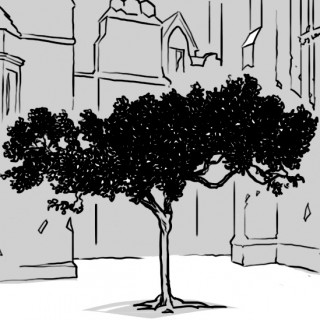
If trees could talk… they’d tell of the miracles and catastrophes that have taken place beneath their boughs.
Pinocchio’s Oak
In a park near Capannori in Tuscany there’s a 600-year-old tree that’s a monument not only to history, but also to literature. It was under this 24-metre oak that Carlo Collodi wrote several chapters of The Adventures of Pinocchio. The tree was the inspiration for several specific scenes. It was near the Big Oak in the story that Pinocchio met the Fox and the Cat. He was also hung from its branches by the robbers. But what’s interesting is that today the tree is known in the area not as Pinocchio’s Oak, but as the Witches’ Oak. Supposedly witches used to meet by it and dance wildly among its branches, giving them their incredible shapes.

Caesar’s Yew
Under this tree in the historic Belgian town of Lo, Julius Caesar himself is said to have taken a snooze more than 2000 years ago, in a break between conquests. Researchers say a road ran nearby during Roman times. The yew itself may also be equally ancient. And while there really isn’t any evidence that Caesar was ever here, the yew has never denied it.

Saved from the glare of a thousand suns
Hibakujumoku is Japanese for ‘survivor tree’ – in this case, a survivor of the atomic bombs dropped on Hiroshima and Nagasaki. Scientists say the shock wave immediately destroyed at least half of the trees within a two-kilometre radius of ground zero. Most of the remaining trees were destroyed by the radiation. Between 10 and several dozen specimens survived, such as a willow and a eucalyptus by the ruins of the castle in Hiroshima, and the centuries-old cinnamon tree in the Sannō Shinto shrine in Nagasaki.

Whispering in the leaves
In the Welsh village of Llangernyw, an ancient yew elicits respect. Some say it’s 1500 years old, while others maintain it’s as much as 4000. But the tree’s age is nothing in comparison to its tenant. The locals say its branches are home to an evil spirit known as Angelystor. If you stand under the yew on Halloween, you’ll hear a mysterious voice: Angelystor will name the villagers who will die during the next year. Useful information! But the curious are scared off by the story of a nosy Welshman who wanted to find out the fate of his neighbours, only to hear Angelystor say his own name.

Signpost in the desert
In Ténéré, in the desert part of Niger, for years there grew an acacia that served as an orientation point for caravans and travellers crossing the wasteland by car. It was the only tree for 400 kilometres around! Unfortunately, in 1973 a certain road warrior drove his car into the lonely acacia. A strange incident, considering how much empty space there was around. The dead tree was brought to a pavilion in a museum in Niamey. Its place in the desert was taken by a metal sculpture.

The constitutional yew
Near the ruins of the Benedictine monastery in Wraysbury, Berkshire, 30 kilometres west of central London, there grows a broad tree that’s at least a millennium old. The British believe that in 1215, in its shade King John and the English barons signed the Magna Carta – the pact that became the basis for the constitutional order and civil liberties in Great Britain. A proud tree, though it can’t be concealed that it’s lost some of its charm. Perhaps because it’s also under this yew, supposedly, that Henry VIII met Anne Boleyn? And this amorous king didn’t do a lot for British democracy.

Like Adam and Eve
The Old Testament Tree of the Knowledge of Good and Evil still draws people, though it no longer bears fruit. It can be seen in the Iraqi town of Al-Kurna. There, between the Tigris and the Euphrates rivers, the Biblical paradise of Eden was said to be located. Today it’s hard to believe; this concrete-encased stump is supposed to be the tree from which Eve plucked the forbidden fruit? Iraq hasn’t looked like paradise for a long time. But let’s remember that according to Near Eastern tradition, in the place of one dying holy tree you plant another. So maybe the Tree of the Knowledge of Good and Evil is still blooming, just somewhere else?

Montezuma’s tree
This is the name of a Mexican cypress, a symbol of the country; it was a holy tree for the indigenous inhabitants. This particular specimen grows in the town of Dolores Hidalgo. Supposedly it’s a descendant of the tree under which in the summer of 1520 Hernán Cortés, leader of the Spanish conquistadores, wept after a bloody retreat from the capital, Tenochtitlán. A bronze monument commemorates the Spaniard. Cortés is kneeling and sobbing – either for his fallen comrades, or for the gold lost during the retreat. But probably not for the slaughter that he had just perpetrated on the Aztecs, ruled by Montezuma.

Righteous among the nations
In the Subcarpathian village of Wiśniowa grows a 65-year-old, 30-metre oak. Known as Józef, it was famous already in the 1920s – its image was on the 100-złoty banknote. But during World War II, the oak played a completely different role. In a broad hole in the tree, the two Hymi brothers hid – Jews who had fled the town of Frysztak. The hiding place was supposedly shown to them by local resident Rozalia Proszak. Józef did a good job; the men survived the occupation.

Macbeth’s ghost
The forest in Birnam, Scotland, whose trees – according to the prediction of the witches from Shakespeare’s play – were to join the fight against the king Macbeth, no longer exists. But one oak has survived that remembers the times when it was surrounded by this forest. Even if it never threatened the historical Macbeth, it’s entirely possible that it inspired Shakespeare. Historians believe that the Bard of Avon visited Birnam with a theatre troupe in 1599. Seven years later, he staged the story of the dark ruler of Scotland for the first time.

The constrictors
The Angkor complex in Cambodia is a magical place. The mighty trees near the Ta Prohm shrine that dates from the 12th–13th centuries literally grew into its history. The giant figs and other trees have grown into the monumental buildings, uprooting them, even devouring them. They themselves are devoured visually by tourists, as can be seen on Facebook and Instagram.

The flood preventer
In Hyderabad, in central India, you can admire a heroic tamarind tree, which resisted a catastrophic flood in 1908. The city was attacked by a cyclone; the streets were flooded by a wave several metres high. In the branches of the tamarind, growing next to the local hospital, 150 people found shelter.

Fig of slaves
In the city of Ndola, Zambia, not far from the border with the Democratic Republic of Congo, there grows a particular fig tree. It rises in the place where 12 years ago a mahogany, known as the Tree of Slaves, fell. It was there that in the 19th century slave traders met, buying prisoners from nearby tribes. Today it’s a place of memory.

Gravity’s apple
In Woolsthorpe Manor, in the English county of Lincolnshire, in an orchard by the family home of Isaac Newton, grows a famous apple tree. It was a fruit falling from this tree that supposedly inspired the scientist to research the force of gravity. In fact, the original tree was knocked over in the 19th century by a wind storm, but a new one grew from its roots. A refreshing metaphor for science, whose development can’t be stopped by any storm of history.

The fig tree of Buddha’s enlightenment
At the shrine of Mahabodhi in Bodh Gaya, in northeast India, grows the so-called Bodhi Tree, the fig tree under which the Buddha meditated and achieved enlightenment more than 2500 years ago. Researchers say it’s not the original tree, but its fourth direct descendant. Its predecessors were destroyed by Tissarakkhā (the jealous wife of the emporer Ashoka) and rulers who were devout Hindus.

Robin Hood’s shelter
In England’s Sherwood Forest can be found the Major Oak – an English oak where in the 13th century Robin Hood and his band are said to have sheltered from the Sheriff of Nottingham’s soldiers. It’s entirely possible that the tree was growing already then; however, it still hasn’t been proven that Robin Hood existed. He seems to be a figure made up of the life stories of many bandits. So maybe it was one of them who hid in the hole in the Major Oak?

The Methuselah pine
In the White Mountains of California grows a long-lived pine known as Methuselah. It’s more than 4800 years old. Its precise location is kept secret by the foresters; they don’t want to provoke fame-seeking vandals. So if you discover Methuselah, don’t tell anybody! This pine is one of the oldest known trees on Earth – not counting a certain spruce in Sweden, which is twice as old, and our next entry…

The antediluvian colony
…Pando is an American aspen colony that’s been living for 80,000 years (though there are theories that it’s been around for one million). The trees are growing from the shoots of a single root, and are genetically identical. This colony is found in Fishlake National Forest in the American state of Utah. It covers 43 hectares, numbering more than 40,000 trunks, and weighs almost 6600 tonnes.

Napoleon’s tree
In Poland’s Warmia-Masuria province stands a tree planted to honour Napoleon Bonaparte’s visit to Elbląg in 1807, and an avenue of pines where the emperor of France supposedly liked to walk. Near the village of Spędy, close to Braniewo, stands a line of trees that bear witness to that era, including almost 30 oaks that remember Napoleon’s march through Prussia. Some are as much as four metres in circumference. Unfortunately, this year an unidentified vandal cut through the dignified trees with a saw, and they dried out; most likely they can’t be rescued. So it’s worth hurrying to see these monuments to history, before they’re reduced to just a monument to human stupidity.

The French chapel
In the town of Allouville-Bellefosse, between Rouen and Le Havre, there grows the oldest oak in France. It looks like something out of a fairy tale: inside the trunk are a chapel and a hermitage from the 17th century, reached by a spiral staircase that winds around the more than 10-metre trunk. But the tree remembers times much older than those of the Sun King; supposedly William the Conqueror himself – the leader of the Normans, with whom he subdued England – knelt before this tree. Some even believe that the tree was planted as far back as the times of Charlemagne, but most likely it’s not as old as all that.

The Nordic giant
In northern European mythology there’s no tree more important than Yggdrasil. This giant brought together different worlds; the squirrel Ratatoskr would bring news between the two. The tree drew its strength from the holy well Urd. The traces of this legend can be seen in the Swedish village of Gamla Uppsala; where a pagan shrine once stood, today there’s a church. Next to pagan burial mounds you can find a plaque informing you that this was the site of the well Urd, and so Yggdrasil also had its roots there. But beware: every bush and even individual trees nearby may be descendants of the Nordic giant.

Translated from the Polish by Nathaniel Espino










